April 2017
On to New Zealand
Who Got our “Lost” Day, and Other Puzzlements of our Travels in the Southern Hemisphere
Well we have finally gotten back to traveling and have arrived in New Zealand. We are delighted. Such a lovely place to be, and just getting lovelier as we wander further. We arrived on March 29, and have finally been able to slow down enough to begin sharing our experiences. Whew!
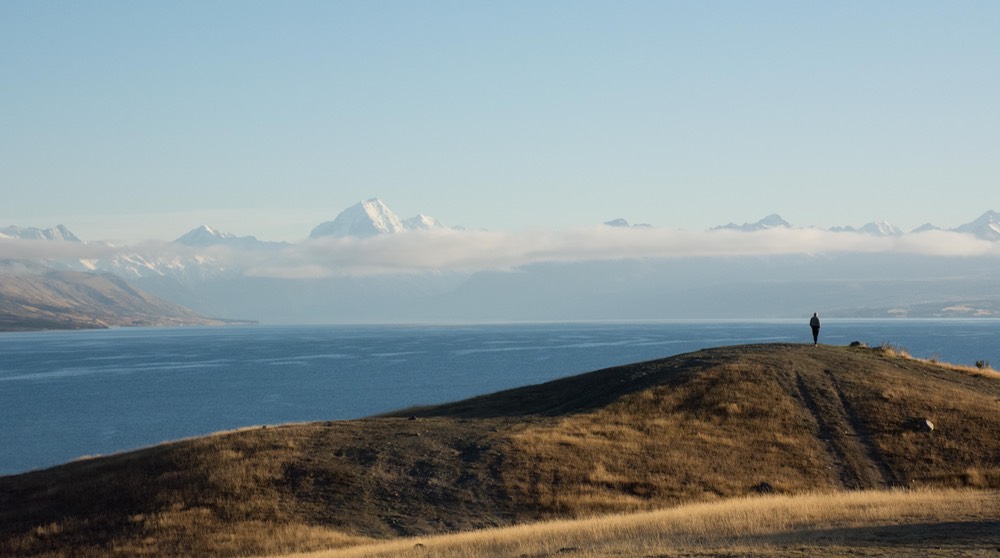
The weird thing about coming to New Zealand is the whole time zone thing. Flying west from the States, things get pretty confusing because you cross the International Date Line (IDL) on the way. We had not done this before. New Zealand is 18 hours ahead of California, so If it is Friday noon in Christchurch, it is Thursday at 6:00 pm on the West Coast of the US. So when we flew from Phoenix to NZ, we left on the evening of March 27th and arrived in Christchurch the morning of the 29th… No, it wasn’t that long a flight, we just lost the 28th altogether. How do you lose a whole day? They tell us we’ll get it back when we fly the other way. Who knew? And why are we trying to explain it all anyway?
We really were lucky to have friends who live north of Christchurch and could pick us up at the airport and take us to their cozy home in Rangiora to recuperate for a couple of days after the long flight. For orientation, Christchurch is the largest city on South Island. Auckland is the largest city on North Island. Wellington, also on North Island, is the capital of New Zealand.
Margaret and Peter took very good care of us, feeding us regularly while giving us plenty of time to get used to the new time and date. We’d met them in Bulgaria several years ago and had stayed in touch. They are an interesting, unique couple and it was a special pleasure seeing them again. But we didn’t just sleep the next couple of days away. We took a nice drive into Christchurch to see how it’s doing after the major, major earthquakes they suffered in late 2010 and early 2011. Rebuilding continues, there is some interesting mural work scattered among the office buildings downtown, and some of the temporary containers that were brought in right after the quakes so that businesses could reopen, have been retained and are now nice little boutiques. It was a nice visit and we enjoyed the day.
We also got a chance to visit the local airfield, where Peter stores two beautiful microlight planes he has built (himself!) and the croquet playing field that he and Margaret, along with some community support, are upgrading and turning into quite a facility. It was a great introduction to home life in NZ.
On April 1 we picked up our camper van, bought food and kitchen necessaries to fill in the gaps, and headed out on our own.
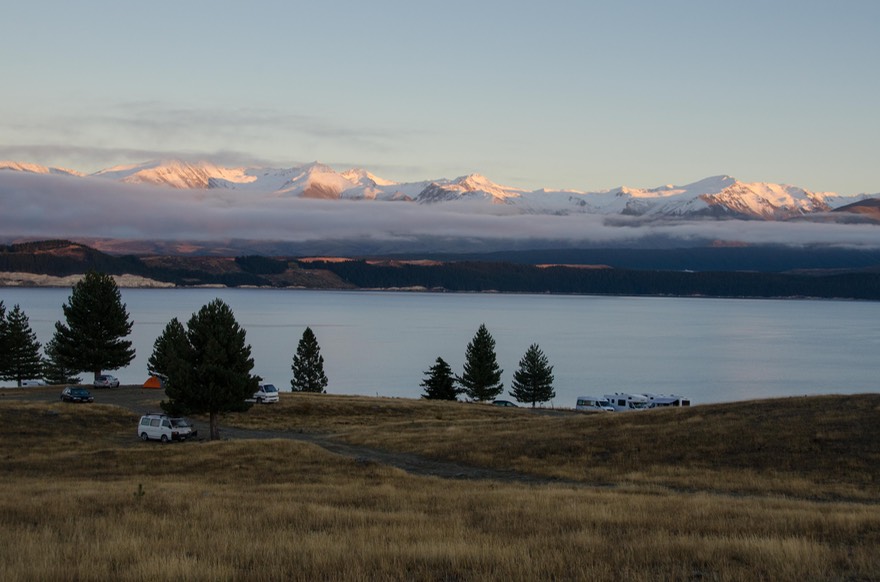
The first cool thing was that we had just a few days earlier found out that an American email friend was also on South Island and not far away. Very neat. We were able to meet up and spend a little time together. He’s an old pro about traveling down here, this being his fifth winter in New Zealand. He had lots to share and advice to give; couldn’t have been better. Thanks, Guy! For me, one of the most special things about our first night camping was that it was a very clear night and the stars were amazing — close, numerous, and really-really different! I kept waking up and peering out the window.
But I was now in full travel mode, and having organized our time on South Island rather carefully (hah!), was chomping at the bit to get started. So the next morning we headed down along the east coast, drifting south along the Canterbury Plain, the fertile growing area of the south. We wanted to head inland toward Wanaka in the central Otago area, but needed more shopping first. We stopped in Timaru for internet at the library, then on to the grocery store… and then the ATM ate our card. At first, we thought the ATM situation occurred because we forgot to call the provider to tell them we were leaving the country. This would have been bad enough, but then it turned out that our cards had expired at the end of March. We must be slipping! Fortunately we already had some mail on the way to us and the new cards were in that mail. Much embarrassment, but no real damage because of course we carry more than one card. You’d think we’d have enough experience in the overseas travel thing to never let something like this happen. Well, think again.
Got the ATM sorted and headed inland into the countryside. We’ve been seeing sheep and cattle and horses for quite awhile now; ahah! now they are joined by pigs and various camelids (llamas & alpacas) and several types of deer. The deer are being raised for meat — “we put them in pies” it seems. We also learned that 85% of the venison eaten in North America and Europe is domestically raised here in New Zealand. Bet you didn’t know that!
We spent the night in nearby Pleasant Point Domain at the Tennis and Rugby Club. We were sorting out some issues with the van and needed to charge the batteries. New Zealand really does their public parks up right: lush grass, open fields and lots of trees, and plenty of places to park up.
Second observation about Down Under: the water goes down the sink swirling clockwise. Now you tell me — which way does it go in your house?
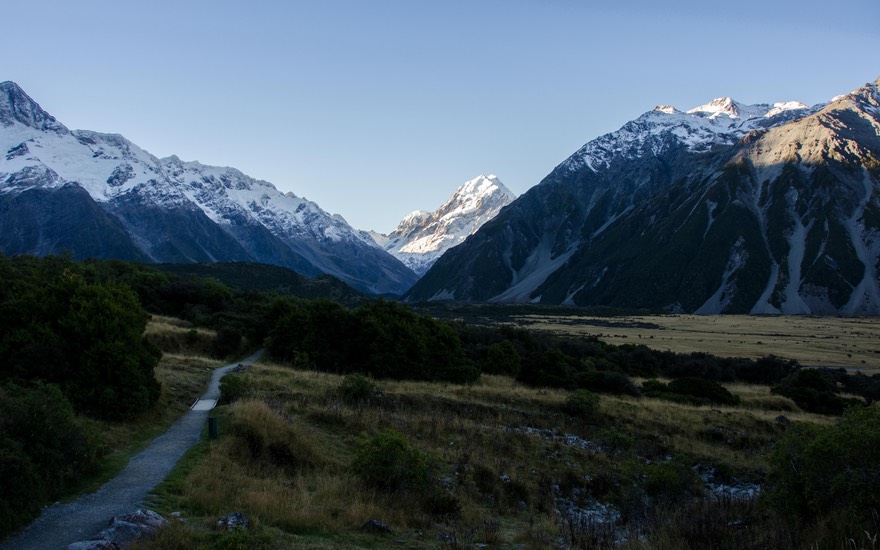
The rolling hills were getting higher as we headed inland; we started to climb up towards Lakes Tekapo and Pukaki and were commenting that the landscape looks sort of like the Scottish Highlands. We are in central South Island, and looking north now at the Southern Alps — quite dramatic.
In a Visitor Center at the bottom of Lake Pukaki we saw a sign in English with translations in Japanese, Korean, Chinese, Filipino and Hindi. Where’s the German, French, etc.? We had been told that many of the tourists coming to NZ now are from Asia and this sign confirmed that, and whenever we came into a tourist hot spot we could see it for ourselves. Speaking of fellow tourists, we are delighted to be here in April and May, which of course is Autumn here. The peak tourist season naturally comes in the summer, which here in the Southern Hemisphere is in the December to March time period.
The visitor center, by the way, was actually mostly an excuse for a salmon store — eat or takeaway. It was jammed with folks chomping away on smoked salmon.
Then we arrived in Wanaka, a beautiful area surrounding a lovely lake and resort, and spent some time with friends Eion and Liza whom we’d met in England at the Silk Route Motorcaravan Club gathering. Eion would be giving a talk several days later in Oamaru, over on the east coast and near Duntroon where their dairy farm is based, so after a lovely couple of days together we made plans to meet up again there so we could visit the farm and go to the talk with them. Then we headed on to Queenstown and Lake Wakatipu, cruising through Arrowtown (the best known gold mining town in the area) along the way. Had a lovely night along Lake Wakatipu. The next morning we drove up to the head of the lake, to Glenorchy, to enjoy walking around the village; it’s a nice little spot. The lake is fed by the Dart River, one of many local names we remember from our time in Great Britain.
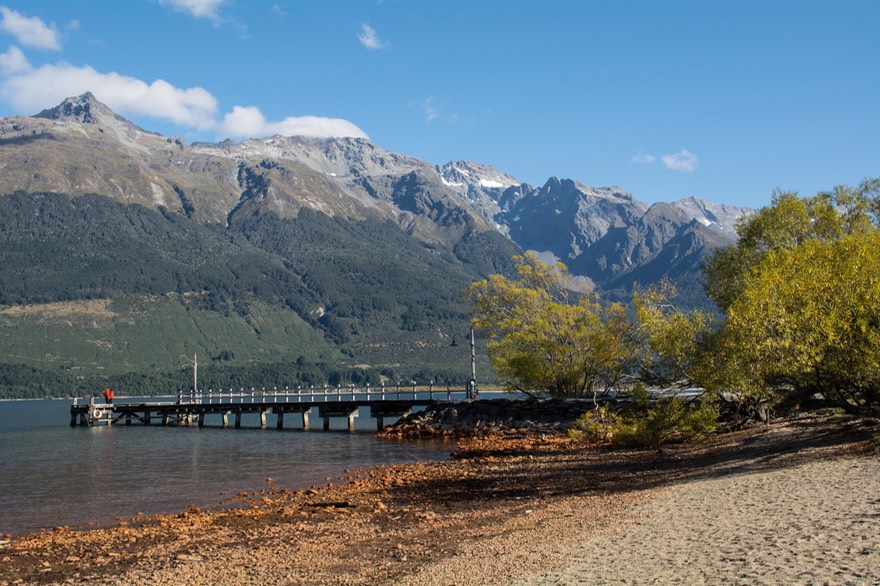
We were beginning to feel a bit limited by the terms of our rental van contract — no gravel or dirt roads (except for short distances to campgrounds) no narrow/twisty roads that are subject to lots of accidents, etc. (Several of them are actually listed in the contract.) Humph. We were missing out on all the things we like to do in the Tiger. Rick wasn’t having any trouble with the left lane and right-hand drive thing— he’s a real pro — but still, some of the narrow roads were a tad harder for him in the larger vehicle — our rental Mercedes van is a little narrower than our Tiger, but is both longer and taller.
Queenstown was indeed a bit of a zoo; it’s the major center of the tourist action for all adventure activities on South Island. We drove through a couple of times on the way to and from the lake and always were interested in the frenetic activity with people arranging for tours and trips and bungee-jumping (they say bungy) and hopping off to a helicopter ride onto a glacier, etc. Zipped through as efficiently as possible. Did our shopping in nearby Frankton instead, where it was considerably easier to park!
Rick had discovered historic car races coming up over the weekend at Highland Park in nearby Cromwell, which also has a nice car museum. So we swung by and had a very nice morning there. I enjoyed the universality of all race track experiences. Eager people arriving and hurrying to see what’s what. Fewer women and girls than men and boys, but plenty of both. Loudspeakers for the announcers. Car, motorcycle, horse —pretty similar. It was a lovely day; I enjoyed the crowd noises and poking around in the coach, reorganizing food and clothing and helping to get us settled in our new digs while Rick took in the races and museum.
By the way, New Zealand is a real hotbed of motorized activities and hosts a number of excellent auto, aviation and motorcycle museums. They have a long established tradition of ‘can-do’ ingenuity that has led to folks like our friend Peter building their own autos and planes, but also to others who collect classics of all sorts. Rick is keeping very busy finding and visiting these museums and it looks like he’ll be adding eight or ten new listings to his Motor-Museums.com website. Great fun!
When we left the races we decided to go back up to Lake Pukaki. It’s the best place on the east side to see Aoraki/Mt Cook, the tallest mountain in NZ, but when we’d come through a few days earlier it had been clouded over and not visible. Today was gorgeous and clear so we went back for another look, it being not too far out of our way.
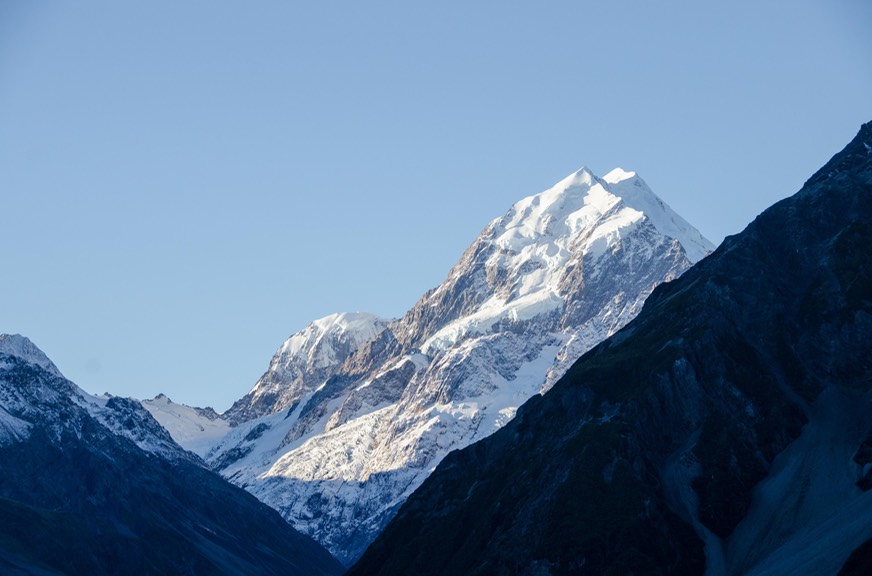
We were really glad we did; when we got there it was getting to be late afternoon. We drove up to the head of the lake, closer and closer to the mountain, taking pictures as the sun got lower and lower in the sky. After getting as close to the mountain as we could we returned to a swell spot to stop for the night. It was back at the foot of the lake, with a great view of all the mountains. We got there at dusk and got to watch the pink glow on the Alps change as the light gave way to darkness. We spent the night there, with a full lovely fat moon for company, and then got up for sunrise and more pictures. A tiny blip was that the bright moon had obscured the stars that would otherwise have taken over the sky. Small matter; over the next few weeks we had many a clear night when we thoroughly enjoyed the evening sky.
Our nearest neighbors for the night (it was a popular spot for campers) was a group of Germans in their 20s (probably), who’d been abroad wandering in various countries for a few months. There were four of them, in two cars. Early in the morning, as we were on a hill waiting for the sun, here came one fellow carrying a girl in a sleeping bag, with her protesting much of the way. Seems sleep was still on her mind but the fellow felt that she needed to see the sunrise, by golly… so he carried her all the way. I took pictures, we all got to chatting, and we have made new friends.
We were now heading for Duntroon and Lundie Braes, Eion and Liza’s dairy farm. The farm has been in Eion’s family for several generations; formerly raising sheep and now working milk cows. We learned a lot about the differences and why the change and got a solid introduction into modern dairy farming techniques. We drank unpasturized milk; ate homemade yoghurt; and, of course, there was the yummy ice cream. We visited nearby cliff pictographs; saw and learned about the great marine fossils in the limestone; and were introduced to ancient Zealandia. There are many fossils on their farm and near by. Pretty cool. And so was Eion’s talk, which was on a trip they’d taken to China a few years back.
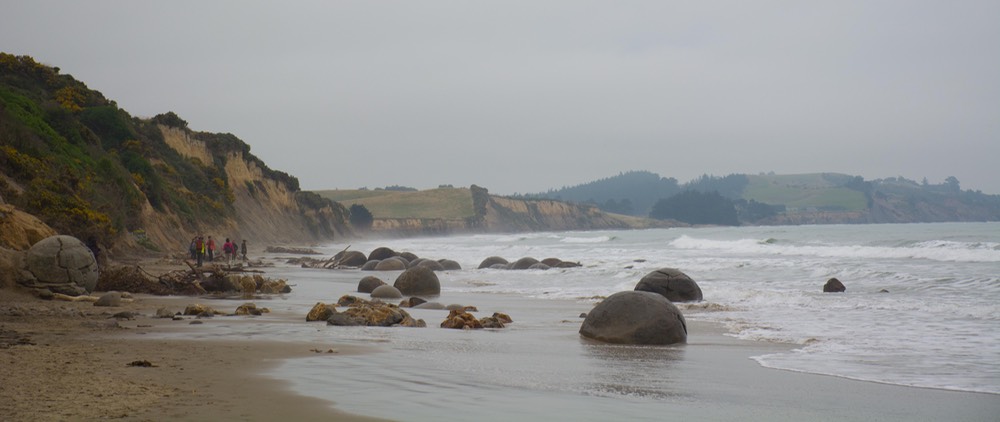
We said good-by the next morning and started on down the east coast to the Moeraki boulders, round rocks that look like bowling balls, right along the shoreline; huge and quite impressive. They are very important to the Maori heritage. A suggestion to anyone heading towards them: find out when low tide is; our visit would have been more dramatic then. We also stopped at the Katike Historic Reserve, which had a path to penguins and sea lions. The lighthouse was nice, but even better, we got close to two yellow-eyed penguins. They can be difficult to find at this time of year, so we thought we were pretty lucky. We spent the night just south of the nearby village, right on the beach. Pretty nifty.
Our ultimate goal at the bottom end of the east coast was Dunedin, and we were looking forward to the visit. But there were a couple of spots in the interior we didn’t want to miss, so we did some meandering first. We turned west a bit at Palmerston, heading toward Ranfurly, an Art Deco town. Art Deco shows up in New Zealand because of the earthquakes. There’d been a quake here in the 30’s which wiped out the place, at a time when architecturally this style was popular. Well, we didn’t see much to have bothered with, but it was a nice town anyway; with a great information center to boot where we booked our ferry crossing to the North Island for a few weeks hence.
Turning south again, on SH87, we trekked on down to Dunedin. It was raining off and on, but it still was a really nice drive. Lots of rolling hills and trees and sheep (etc), through towns with solid old limestone churches. We reluctantly passed by the signs offering Horse poo and Sheep poo.
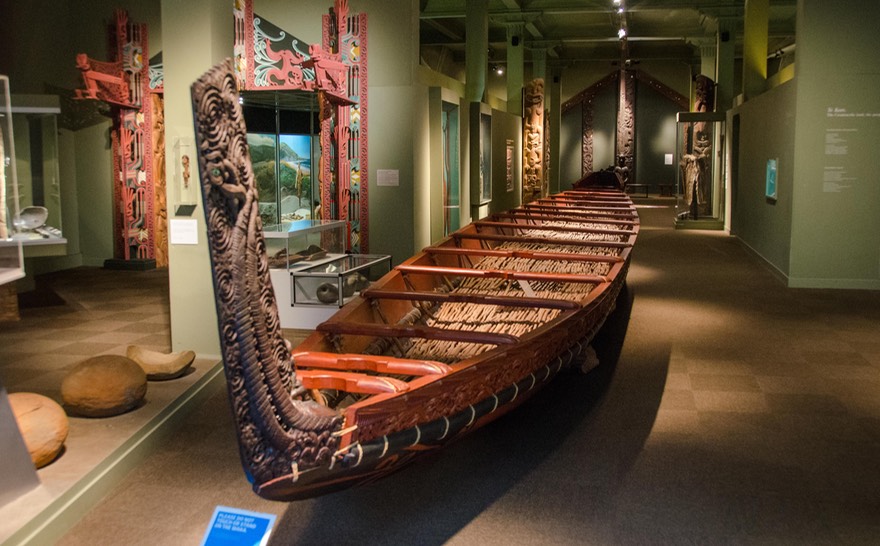
Dunedin is sort of in the southeastern corner of South Island. It’s a very old city with a nice city center. Founded by Scottish immigrants and home of New Zealand’s oldest university, it is often referred to as the ‘Edinburgh of the South’. There was lots to enjoy. The cathedral had some interesting architectural elements and a very nice statue of Robert Burns in the park.
There were also two really good museums to be enjoyed. On our first day there we walked to the university to see the terrific Otago Museum. It has a great collection of southern Māori tooka in the Tāngata Whenua gallery, plus excellent information on the Europeans who settled in the Southland and the difficulties they faced. It also has an excellent Natural History section and a special exhibit on Sir Edmund Hillary, the New Zealander who, with his Sherpa guide Tenzing Norgay, first climbed Mt. Everest in 1953. We spent a long time there. It was great. The next morning we came back into town to visit the second museum, the Toitū Museum (aka the Settlers museum) which is also quite excellent, with a wide ranging exhibit of different aspects of the settlement of the country. Interestingly, both of these museums were donation only. We know that some of New Zealand’s museums are pretty expensive for tourists.
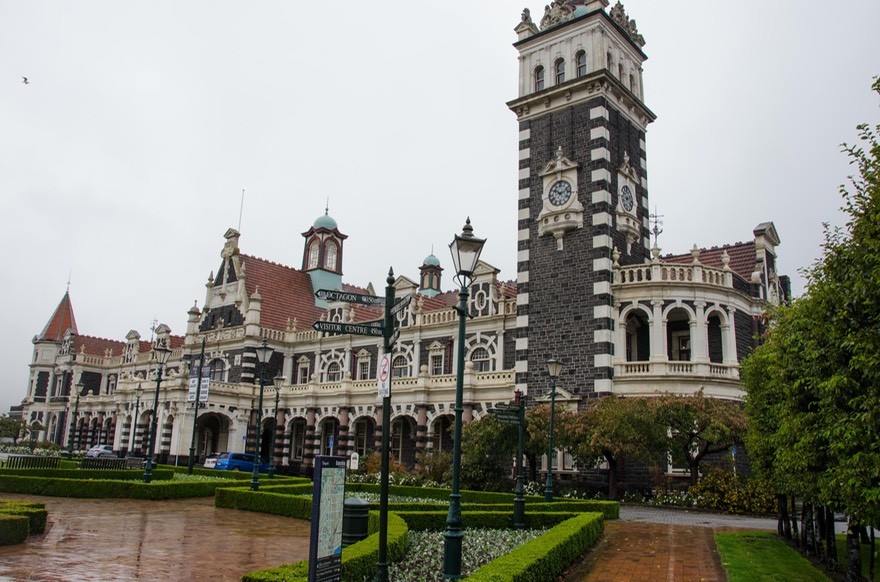
But the biggest highlight of our very rainy visit to Dunedin was its famous railway station, built in 1906. It’s in excellent condition and quite dramatic both inside and out. The mosaic floors in the interior are a real sight to see. We wandered and enjoyed and had coffee in the old cafe in the interior. We were able to park in the lot there and walk to everything we wanted to see in the city.
We spent two days wandering Dunedin, camping both nights at nearby Brighton Beach in a free camping area next to the rugby and tennis club. We were parked on a cliffside overlooking the bay, and it was a terrific spot, with crashing waves, lots of wind, and a great beach.
The rain was forecast to continue and it was about to be Easter weekend so we decided to go further inland for a bit, and then return. Libraries were closed, there were a lot of folks cluttering up the interesting places, and we were hoping for better weather to go out and enjoy the Otago Peninsula, with the possibility of seeing albatrosses. The fellow we talked to at the visitors center agreed there was no point in going out there in the rain. Because of the weather we also skipped the Chinese Garden, although it looked quite enticing.
In the end we had to bail on the albatrosses when we decided to not return to Dunedin following the weekend. Despite the fact that we had plenty of time, we were beginning to think it was slipping away. Even more importantly, we were trying hard to make the most of our windows of good weather and we wanted to drive the Southern Scenic Route in sunshine if we could.
So we wandered off for a couple of days back into the interior to see more of the countryside in slightly better weather. The fields were filled with standing water and there were a lot of soggy sheep, but we had a good time, and found places to stay where we wouldn’t have problems with getting stuck.
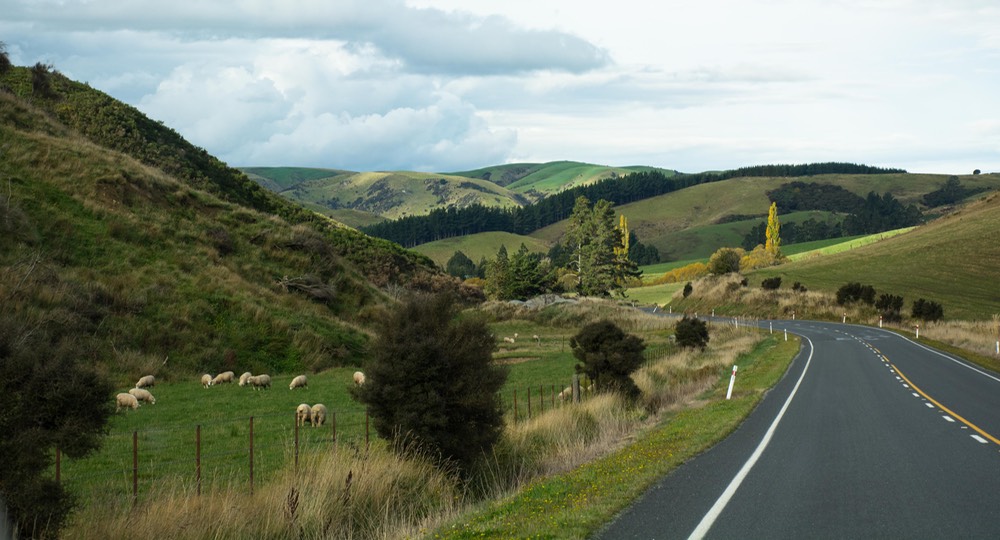
Our wander took us to Mandeville, to visit the Aerodrome there, with its superb collection of DeHavilland planes, some under restoration, plus other interesting items. It was quite nifty. The road there went between the towns of Clinton and Gore (along the Presidential Highway, of course!), and Gore was a really good place to visit. It’s very friendly to people in motorhomes, for one thing. Also, it claims to be the brown trout capital of the world, complete with a terrific statue at the entrance to the town. It is a pretty town as well, with a really nice local museum in the visitor center. Do go there.
And then we had two delightful days near Lawrence, Otago’s original gold town. Lots of mining sites to visit, for those interested in all that. Growing up in California, we mostly leave that be, but the area has been nicely maintained without becoming too touristy, and it’s a lovely region. Locals showed us a terrific place to camp, down a narrow road (with ripe blackberries to be picked) and alongside a pond off Gabriel’s Gully Road, in the reserve there. Really pretty, with fall color creeping in. On Easter there was an egg hunt in the village. We think that if a visitor wants to visit the gold country, and is deciding between the much better known Arrowtown near Queenstown, and here in Lawrence, come here instead. Far more charming.
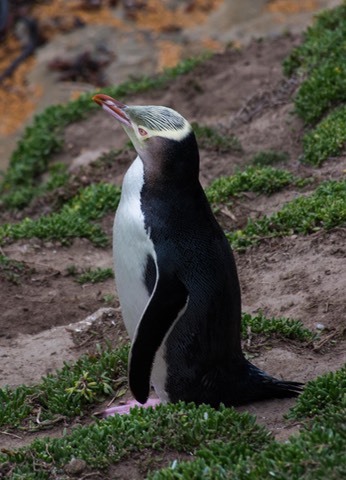
Getting ready to head on around the southern coast, we were pleased we were reaching the end of the long Easter weekend. And a long weekend it was, indeed. The whole world shuts town starting on Good Friday, and then opens up on Tuesday…mostly. In the Southland, where we were, the Tuesday is also a regional holiday for many, so the libraries didn’t open up until Wednesday. A long time without connectivity. But we suffered through!
Well we’d better quit here ‘cause this message is getting too long. We’ll get this one sent out and then start work on our next installment.
Oh, and that “lost” day we suffered in crossing the IDL? We bequeath it to each and every one of you. It’s an extra day for you to take when you’re feeling swamped and beginning to panic. It’s a magic day, filled with as many hours as needed, and includes time for a quiet nap under a tree in the back yard. With lots of love from us.
Rick & Kathy… a little sad with no Tiger to keep us company
Click to see more photos from On to New Zealand